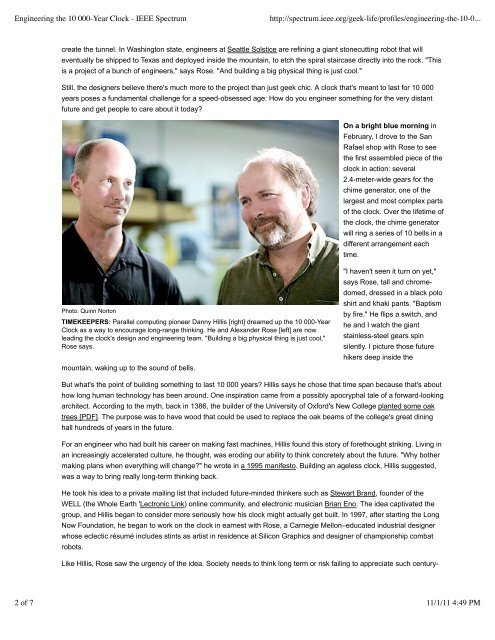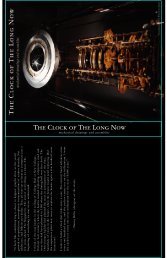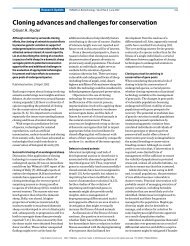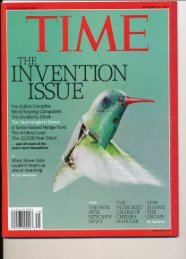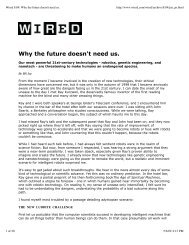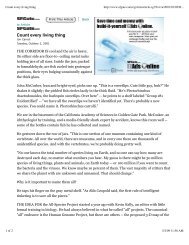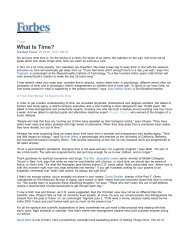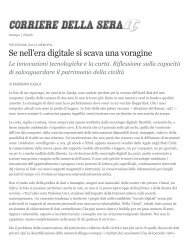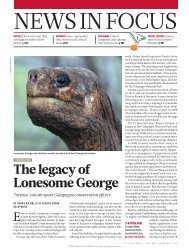PDF Download - Long Now Foundation
PDF Download - Long Now Foundation
PDF Download - Long Now Foundation
You also want an ePaper? Increase the reach of your titles
YUMPU automatically turns print PDFs into web optimized ePapers that Google loves.
Engineering the 10 000-Year Clock - IEEE Spectrum http://spectrum.ieee.org/geek-life/profiles/engineering-the-10-0...<br />
create the tunnel. In Washington state, engineers at Seattle Solstice are refining a giant stonecutting robot that will<br />
eventually be shipped to Texas and deployed inside the mountain, to etch the spiral staircase directly into the rock. "This<br />
is a project of a bunch of engineers," says Rose. "And building a big physical thing is just cool."<br />
Still, the designers believe there's much more to the project than just geek chic. A clock that's meant to last for 10 000<br />
years poses a fundamental challenge for a speed-obsessed age: How do you engineer something for the very distant<br />
future and get people to care about it today?<br />
Photo: Quinn Norton<br />
TIMEKEEPERS: Parallel computing pioneer Danny Hillis [right] dreamed up the 10 000-Year<br />
Clock as a way to encourage long-range thinking. He and Alexander Rose [left] are now<br />
leading the clock's design and engineering team. "Building a big physical thing is just cool,"<br />
Rose says.<br />
mountain, waking up to the sound of bells.<br />
On a bright blue morning in<br />
February, I drove to the San<br />
Rafael shop with Rose to see<br />
the first assembled piece of the<br />
clock in action: several<br />
2.4-meter-wide gears for the<br />
chime generator, one of the<br />
largest and most complex parts<br />
of the clock. Over the lifetime of<br />
the clock, the chime generator<br />
will ring a series of 10 bells in a<br />
different arrangement each<br />
time.<br />
"I haven't seen it turn on yet,"<br />
says Rose, tall and chrome-<br />
domed, dressed in a black polo<br />
shirt and khaki pants. "Baptism<br />
by fire." He flips a switch, and<br />
he and I watch the giant<br />
stainless-steel gears spin<br />
silently. I picture those future<br />
hikers deep inside the<br />
But what's the point of building something to last 10 000 years? Hillis says he chose that time span because that's about<br />
how long human technology has been around. One inspiration came from a possibly apocryphal tale of a forward-looking<br />
architect. According to the myth, back in 1386, the builder of the University of Oxford's New College planted some oak<br />
trees [<strong>PDF</strong>]. The purpose was to have wood that could be used to replace the oak beams of the college's great dining<br />
hall hundreds of years in the future.<br />
For an engineer who had built his career on making fast machines, Hillis found this story of forethought striking. Living in<br />
an increasingly accelerated culture, he thought, was eroding our ability to think concretely about the future. "Why bother<br />
making plans when everything will change?" he wrote in a 1995 manifesto. Building an ageless clock, Hillis suggested,<br />
was a way to bring really long-term thinking back.<br />
He took his idea to a private mailing list that included future-minded thinkers such as Stewart Brand, founder of the<br />
WELL (the Whole Earth 'Lectronic Link) online community, and electronic musician Brian Eno. The idea captivated the<br />
group, and Hillis began to consider more seriously how his clock might actually get built. In 1997, after starting the <strong>Long</strong><br />
<strong>Now</strong> <strong>Foundation</strong>, he began to work on the clock in earnest with Rose, a Carnegie Mellon–educated industrial designer<br />
whose eclectic résumé includes stints as artist in residence at Silicon Graphics and designer of championship combat<br />
robots.<br />
Like Hillis, Rose saw the urgency of the idea. Society needs to think long term or risk failing to appreciate such century-<br />
2 of 7 11/1/11 4:49 PM


